BIN1 localizes the L-type calcium channel to cardiac T-tubules
- PMID: 20169111
- PMCID: PMC2821894
- DOI: 10.1371/journal.pbio.1000312
BIN1 localizes the L-type calcium channel to cardiac T-tubules
Abstract
The BAR domain protein superfamily is involved in membrane invagination and endocytosis, but its role in organizing membrane proteins has not been explored. In particular, the membrane scaffolding protein BIN1 functions to initiate T-tubule genesis in skeletal muscle cells. Constitutive knockdown of BIN1 in mice is perinatal lethal, which is associated with an induced dilated hypertrophic cardiomyopathy. However, the functional role of BIN1 in cardiomyocytes is not known. An important function of cardiac T-tubules is to allow L-type calcium channels (Cav1.2) to be in close proximity to sarcoplasmic reticulum-based ryanodine receptors to initiate the intracellular calcium transient. Efficient excitation-contraction (EC) coupling and normal cardiac contractility depend upon Cav1.2 localization to T-tubules. We hypothesized that BIN1 not only exists at cardiac T-tubules, but it also localizes Cav1.2 to these membrane structures. We report that BIN1 localizes to cardiac T-tubules and clusters there with Cav1.2. Studies involve freshly acquired human and mouse adult cardiomyocytes using complementary immunocytochemistry, electron microscopy with dual immunogold labeling, and co-immunoprecipitation. Furthermore, we use surface biotinylation and live cell confocal and total internal fluorescence microscopy imaging in cardiomyocytes and cell lines to explore delivery of Cav1.2 to BIN1 structures. We find visually and quantitatively that dynamic microtubules are tethered to membrane scaffolded by BIN1, allowing targeted delivery of Cav1.2 from the microtubules to the associated membrane. Since Cav1.2 delivery to BIN1 occurs in reductionist non-myocyte cell lines, we find that other myocyte-specific structures are not essential and there is an intrinsic relationship between microtubule-based Cav1.2 delivery and its BIN1 scaffold. In differentiated mouse cardiomyocytes, knockdown of BIN1 reduces surface Cav1.2 and delays development of the calcium transient, indicating that Cav1.2 targeting to BIN1 is functionally important to cardiac calcium signaling. We have identified that membrane-associated BIN1 not only induces membrane curvature but can direct specific antegrade delivery of microtubule-transported membrane proteins. Furthermore, this paradigm provides a microtubule and BIN1-dependent mechanism of Cav1.2 delivery to T-tubules. This novel Cav1.2 trafficking pathway should serve as an important regulatory aspect of EC coupling, affecting cardiac contractility in mammalian hearts.
Conflict of interest statement
The authors have declared that no competing interests exist.
Figures
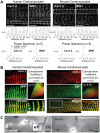


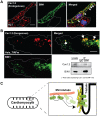
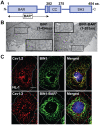
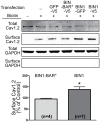
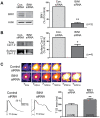
Comment in
-
Synopsis. BIN1: a protein with great heart.PLoS Biol. 2010 Feb 16;8(2):e1000311. doi: 10.1371/journal.pbio.1000311. PLoS Biol. 2010. PMID: 20169110 Free PMC article. No abstract available.
References
-
- Butler M. H, David C, Ochoa G. C, Freyberg Z, Daniell L, et al. Amphiphysin II (SH3P9; BIN1), a member of the amphiphysin/Rvs family, is concentrated in the cortical cytomatrix of axon initial segments and nodes of ranvier in brain and around T tubules in skeletal muscle. J Cell Biol. 1997;137:1355–1367. - PMC - PubMed
-
- Lee E, Marcucci M, Daniell L, Pypaert M, Weisz O. A, et al. Amphiphysin 2 (Bin1) and T-tubule biogenesis in muscle. Science. 2002;297:1193–1196. - PubMed
Publication types
MeSH terms
Substances
Grants and funding
LinkOut - more resources
Full Text Sources
Other Literature Sources
Molecular Biology Databases
Research Materials

